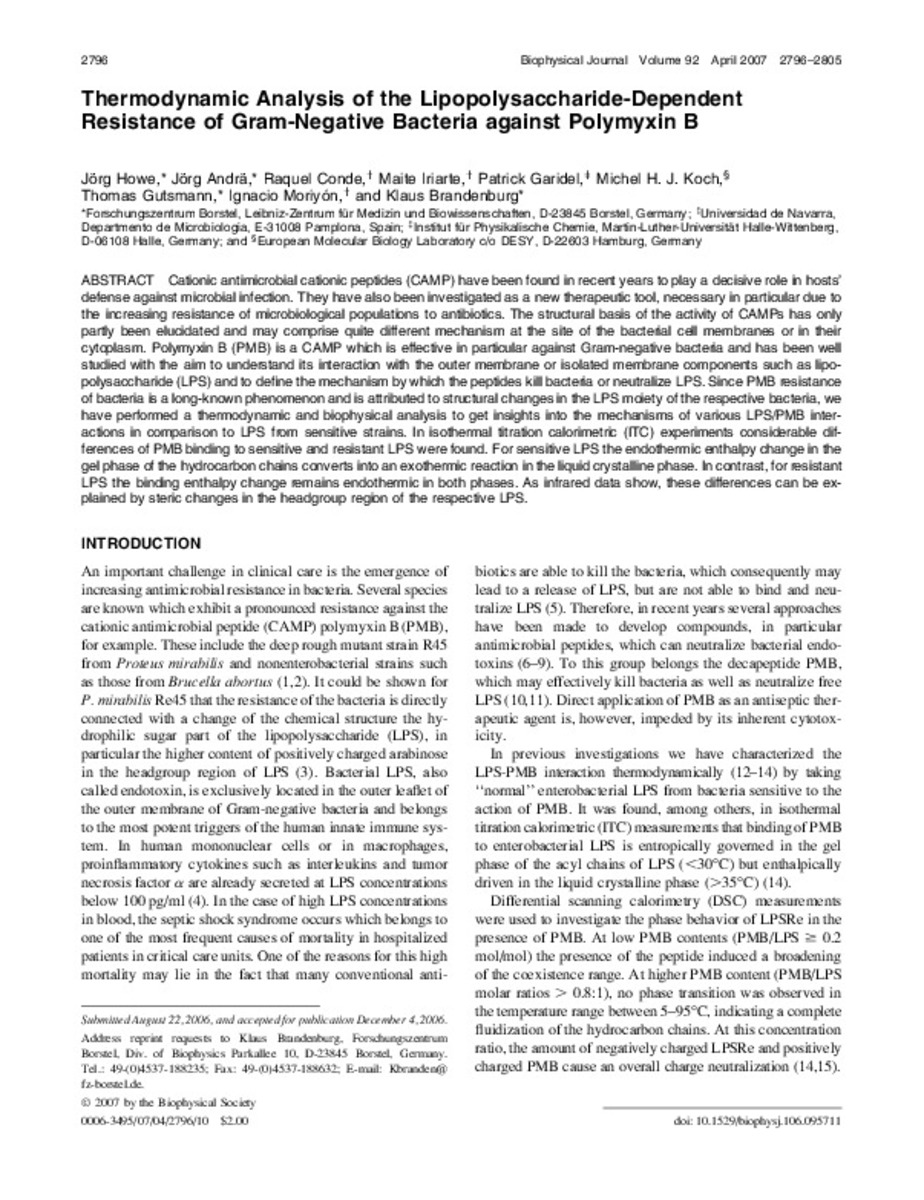Full metadata record
| DC Field | Value | Language |
|---|---|---|
| dc.creator | Howe, J. (Jörg) | - |
| dc.creator | Andrä, J. (Jörg) | - |
| dc.creator | Raquel | - |
| dc.creator | Iriarte, M. (Maite) | - |
| dc.creator | Garidel, P. (Patrick) | - |
| dc.creator | Koch, M.H.J. (Michel H. J.) | - |
| dc.creator | Gutsmann, T. (Thomas) | - |
| dc.creator | Moriyon, I. (Ignacio) | - |
| dc.creator | Brandenburg, K. (Klaus) | - |
| dc.date.accessioned | 2013-06-14T09:02:12Z | - |
| dc.date.available | 2013-06-14T09:02:12Z | - |
| dc.date.issued | 2007 | - |
| dc.identifier.citation | Howe J, Andra J, Conde R, Iriarte M, Garidel P, Koch MH, et al. Thermodynamic analysis of the lipopolysaccharide-dependent resistance of gram-negative bacteria against polymyxin B. Biophys J 2007; 92(8); 2796-2805. | es_ES |
| dc.identifier.issn | 0006-3495 | - |
| dc.identifier.uri | https://hdl.handle.net/10171/29364 | - |
| dc.description.abstract | Cationic antimicrobial cationic peptides (CAMP) have been found in recent years to play a decisive role in hosts' defense against microbial infection. They have also been investigated as a new therapeutic tool, necessary in particular due to the increasing resistance of microbiological populations to antibiotics. The structural basis of the activity of CAMPs has only partly been elucidated and may comprise quite different mechanism at the site of the bacterial cell membranes or in their cytoplasm. Polymyxin B (PMB) is a CAMP which is effective in particular against Gram-negative bacteria and has been well studied with the aim to understand its interaction with the outer membrane or isolated membrane components such as lipopolysaccharide (LPS) and to de. ne the mechanism by which the peptides kill bacteria or neutralize LPS. Since PMB resistance of bacteria is a long-known phenomenon and is attributed to structural changes in the LPS moiety of the respective bacteria, we have performed a thermodynamic and biophysical analysis to get insights into the mechanisms of various LPS/PMB interactions in comparison to LPS from sensitive strains. In isothermal titration calorimetric (ITC) experiments considerable differences of PMB binding to sensitive and resistant LPS were found. For sensitive LPS the endothermic enthalpy change in the gel phase of the hydrocarbon chains converts into an exothermic reaction in the liquid crystalline phase. In contrast, for resistant LPS the binding enthalpy change remains endothermic in both phases. As infrared data show, these differences can be explained by steric changes in the headgroup region of the respective LPS. | es_ES |
| dc.language.iso | eng | es_ES |
| dc.publisher | Elsevier | es_ES |
| dc.rights | info:eu-repo/semantics/openAccess | es_ES |
| dc.subject | Antimicrobial peptides | es_ES |
| dc.subject | Salmonella Minnesota | es_ES |
| dc.subject | Synchrotron radiation | es_ES |
| dc.subject | Biological activity | es_ES |
| dc.subject | Escherichia coli | es_ES |
| dc.subject | Divalent cations | es_ES |
| dc.subject | Lipid A | es_ES |
| dc.subject | Temperature | es_ES |
| dc.subject | Mutants | es_ES |
| dc.subject | Rough | es_ES |
| dc.title | Thermodynamic analysis of the lipopolysaccharide-dependent resistance of gram-negative bacteria against polymyxin B | es_ES |
| dc.type | info:eu-repo/semantics/article | es_ES |
| dc.type.driver | info:eu-repo/semantics/article | es_ES |
| dc.identifier.doi | http://dx.doi.org/10.1529/biophysj.106.095711 | es_ES |
Files in This Item:
Statistics and impact
Items in Dadun are protected by copyright, with all rights reserved, unless otherwise indicated.






